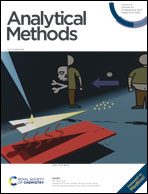Research on a three-dimensional SERS substrate based on a CNTs/Ag@Au/SiO2 composite for detection of fipronil and imidacloprid pesticides
Abstract
Surface-enhanced Raman scattering (SERS) has a unique fingerprint spectrum, which allows for rapid, highly sensitive, and non-destructive detection without the need for sample pretreatment. However, SERS substrates have disadvantages such as short storage time and poor reproducibility. In this study, carbon nanotubes, gold, and silver were combined to take advantage of their inherent structural and characteristic properties that enhance the Raman effect. A new type of SERS composite substrate, CNTs/Ag@Au/SiO2, was prepared using a hydrothermal method and seed growth method. The substrate was characterized using transmission electron microscopy (TEM), and the average distance between the core–shell nanoparticles was found to be 3.1 nm, which is more suitable than other gold–silver combined core–shell structures and significantly improves the SERS enhancement factor. The substrate demonstrated high sensitivity even at low concentrations of probe molecules and good uniformity at five randomly selected locations. After storage for 45 days, the substrate still exhibited good stability. In most gold–silver combined core–shell structures, the detection limit for Rhodamine 6G (R6G) is 10−9 mol L−1, while in this substrate, the detection limit for R6G is 10−11 mol L−1. Furthermore, the contribution of the substrate's enhancement was deeply investigated using finite-difference time-domain (FDTD), which revealed that the substrate's hotspots were present in two forms: the “hotspots generated between Ag@Au nanoparticles” and the “hotspots generated between Ag@Au nanoparticles and carbon nanotubes”. These two forms of hotspots also demonstrated that the performance brought about by the preparation of the substrate structure was reliable. The simulation results were compared with the experimental results, and the analysis showed that the real environment would have an impact on the substrate's structure during the actual substrate preparation process. Finally, the substrate was used for detecting the pesticide fipronil, and the results showed clear peaks even at a concentration of 0.1 mg L−1. The results indicated that the Raman intensity was linearly exponential with the fipronil solution concentration, with a determination coefficient of R2 = 0.991. This study provides a new SERS substrate for pesticide residue detection and further explores the improvement of pesticide detection limits.



 Please wait while we load your content...
Please wait while we load your content...